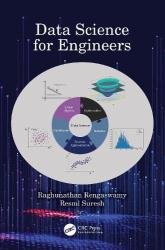 Название: Data Science for Engineers
Название: Data Science for EngineersАвтор: Raghunathan Rengaswamy, Resmi Suresh
Издательство: CRC Press
Год: 2023
Страниц: 361
Язык: английский
Формат: pdf (true)
Размер: 13.4 MB
With tremendous improvement in computational power and availability of rich data, almost all engineering disciplines use Data Science at some level. This textbook presents material on Data Science comprehensively, and in a structured manner. It provides conceptual understanding of the fields of Data Science, Machine Learning (ML), and Artificial Intelligence (AI), with enough level of mathematical details necessary for the readers. This will help readers understand major thematic ideas in Data Science, Machine Learning, and Artificial Intelligence, and implement first-level Data Science solutions to practical engineering problems.
With tremendous improvement in computational power and availability of rich data, almost all engineering disciplines are caught in the data science (DS) tsunami. Technical developments in the area of DS are happening at a break-neck speed. In the current scenario, there is a cacophony of information on DS, machine learning (ML), and artificial intelligence (AI). There are several claims and counter-claims that are made regarding the effectiveness of these approaches. A beginner learner would find all of this bewildering and difficult to comprehend. Further, the mathematical background that is needed to understand this field seems daunting. In the midst of all this, the reality is that it is imperative that all engineering students have a good understanding of this field, much like how almost all engineering students are expected to have a reasonable knowledge and grounding in mathematics. While there are multiple resources that are available for learning this field, they are generally not organized to suit a first-level course in an undergraduate engineering curriculum. Most of these resources are targeted at professionals to enable them to reskill and quickly transition into this domain.
The aim of this book is to present material on DS comprehensively and in a structured manner such that this book can be used in an undergraduate engineering classroom. The intent is to introduce students to basic concepts in DS, ML, and AI. The orientation is toward providing a conceptual understanding of the field with a sufficient level of mathematical detail required for beginners. At the end of the course, students will be expected to understand major thematic ideas in DS, ML, and AI and be able to implement first-level DS solutions to practical engineering problems of interest.
One of the important aspects of DS is that it cuts across several disciplines. This would necessarily mean that there are core topics that are largely domain agnostic (much like mathematics, statistics, and so on) and these ideas can be isolated from domain specific details. As a result, the material is generalized and couched in a mathematical framework.
The book:
Provides a systematic approach for understanding data science techniques
Explain why machine learning techniques are able to cross-cut several disciplines.
Covers topics including statistics, linear algebra and optimization from a data science perspective.
Provides multiple examples to explain the underlying ideas in machine learning algorithms
Describes several contemporary machine learning algorithms
The textbook is primarily written for undergraduate and senior undergraduate students in different engineering disciplines including chemical engineering, mechanical engineering, electrical engineering, electronics and communications engineering for courses on data science, machine learning and Artificial Intelligence.
Table of Contents:
Chapter 1. Introduction to DS, ML AI
Chapter 2. DS and ML - fundamental concepts
Chapter 3. Linear algebra for DS and ML
Chapter 4. Optimization for DS and ML
Chapter 5. Statistical foundations for DS and ML
Chapter 6. Function approximation methods
Chapter 7. Classification methods
Chapter 8. Conclusions and future directions
References
Index
Скачать Data Science for Engineers